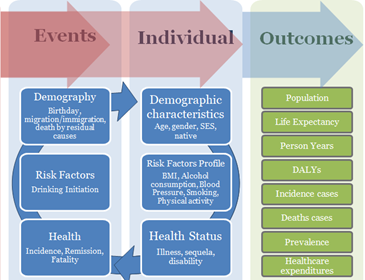Modelling the burden of disease¶
Purpose of the model¶
OECD’s Strategic Public Health Planning for NCDs (SPHeP-NCD) model consolidates previous OECD modelling work to produce a comprehensive set of key behavioural and physiological risk factors (e.g. obesity, physical activity, blood pressure) and their associated non-communicable diseases (NCDs).
At a high-level, the model predicts population health outcomes up until year 2050 at the country or regional level by comparing outputs across two scenarios – 1) baseline scenario (risk factors and diseases prevalence in the absence of interventions); and 2) intervention scenario (epidemiological impact of an intervention at the population level).
Results from the model are designed to inform evidence-based public health policy and strategic planning.
Core modules¶
At the core of the model are three modules: the Demographic module (e.g. date of birth, migration/emigration); the Risk factors (e.g. alcohol consumption); and the Disease module (e.g. disease incidence and fatality) (see Fig. 1 for an overview).
Individuals in the model are ascribed a set of demographic, disease and risk factors (i.e. the three main modules). The model covers the entire lifetime of individuals, that is, individuals enter the model when they are born and exit when they die; these are just two ‘events’ experienced by the individuals (i.e. the demographic module). Other randomly determined ‘events’ experienced by individuals are disease incidence, remission, fatality and prevalence (i.e. the disease module). The disease ‘event’ with the shortest time span will affect individuals first and will have a ‘knock-on’ effect on subsequent ‘events’, that is, the model takes into account the causal relationship between diseases. For example, individuals who develops diabetes will be more likely (than before diabetes incidence) to have hypertension. Unlike diseases, risk factors remain consistent over time. Specifically, when individuals enter the model, they are allocated a fixed quantile for each risk factor, which does not change over time (e.g. the BMI od individuals may increase with age, however, so too will the overall population’s, thus indivuduals remains in the same position).

Fig. 1 SPHeP-NCD Modelling Framework¶
Synthetic life histories¶
The model uses case-based microsimulation to create synthetic life histories (i.e. from birth to death) which provides multiple cross-sectional representations of a population during two periods, the ‘validation period’ and the ‘projection period’
In the validation period (1990-2015), simulated and historical data are used to validate or calibrate the model (i.e. to coherently reproduce the cross-sectional distribution of the population based on available statistics).
In the projection period (2016-2050), quantitative estimates of the future global burden of chronic NCDs are modelled, including potential policy impacts.
Geographic and time coverage¶
At present, the SPHeP-NCD model can produce results for 52 countries. The model, however, is capable of extending to nearly all countries
